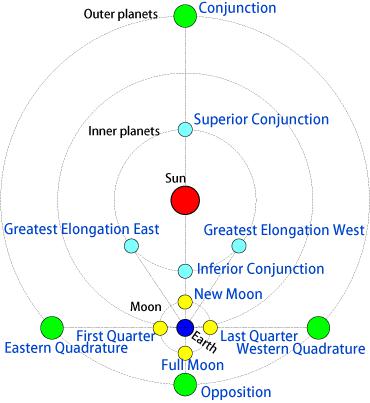PLEASE NOTE THE BELOW SUMMARY AND GUIDE IS FOR AN APPROXIMATE LATITUDE OF 55 DEGREES NORTH
OBSERVING GUIDE
(Please note all times are ST and are based on an observing location of Belfast and covers the month of August)
The Sun
At the start of the month, the Sun rises at 05:35 and sets at 21:20. By month’s end, it rises at 06:30 and sets at 20:15.
The Planets
Conjunction
On the morning of the 15th, the gap between Mars and Jupiter will be approximately a third of a degree. Mars will lie above and to the left of Jupiter. The planets will be visible from 01:00.
Regular Stuff
Mercury is at inferior conjunction on the 19th and is visible at the end of the month in the morning sky, albeit it is very low. At the end of the month it rises at 05:05 and is mag +0.8 in Leo.
Venus is not visible this month.
Mars is visible in the morning sky during the month in Taurus. At the start of the month, it rises at 00:55 and by month’s end it rises at 00:05. It brightens from mag +0.9 to mag +0.7 during the month.
Jupiter is visible in the morning sky during the month in Taurus. At the start of the month, it rises at 01:20 and by month’s end it rises at 23:35. It brightens from mag -2.0 to mag -2.1 during the month.
Saturn becomes visible in the evening sky during the month in Aquarius. At the start of the month, it rises at 22:40 and by month’s end it rises at 20:40. It brightens from mag +0.8 to mag +0.6 during the month.
Uranus is at western quadrature on the 19th and becomes visible in the evening sky during the month in Taurus. At the start of the month, it rises at 00:25 and by month’s end it rises at 22:25. It brightens from mag +5.8 to mag +5.7 during the month.
Neptune becomes visible in the evening sky during the month in Pisces. At the start of the month, it rises at 22:50 and by month’s end it rises at 20:50. It maintains its brightness at mag +7.8 during the month.
The Moon
The new moon is on the 4th (12:13). The first quarter moon is on the 12th (16:18). The full moon is on the 19th (19:25). The last quarter moon of the month is on the 26th (10:25).
Occultations
On the morning of the 21st, the planet Saturn will disappear from view for a time behind the moon. It will disappear around 04:25 and reappear around 05:05.
On the morning of the 26th, the moon partly occults M45 – The Pleiades, passing in front of the lower bit of the cluster from 02:00.
Regular Stuff
9th pm the 25% waxing crescent moon lies right of Spica (Alpha (α) Virginis, mag +1.0) at 22:00.
10th pm the 33% waxing crescent moon lies left of Spica (Alpha (α) Virginis, mag +1.0) at 22:00.
13th pm the 62% waxing gibbous moon lies below right of Antares (Alpha (α) Scorpii, mag +0.9) at 22:00.
14th pm the 72% waxing gibbous moon lies left of Antares (Alpha (α) Scorpii, mag +0.9) at 22:00.
20th pm the 98% waning gibbous moon lies right of Saturn at 22:00.
21st pm the 93% waning gibbous moon lies below right of Neptune at 22:00. The gap between Neptune and the moon’s edge is less than 10 arcminutes.
25th pm the 55% waning gibbous moon lies above Uranus and right of M45 – The Pleiades at 23:00.
27th am the 43% waning crescent lies above right of Mars and Jupiter and above left of Aldebaran (Alpha (α) Tauri, mag +0.9) at 01:00.
28th am the 33% waning crescent lies above left of Mars and left of Jupiter at 01:00.
Meteors
The best time to observe meteor showers is when the moon is below the horizon; otherwise its bright glare limits the number you will see especially the fainter ones. Below is a guide to this month’s showers.
The Perseids peak around 15:00 on the 12th with a ZHR of 100. The radiant is visible as soon as darkness falls on the evenings of the 11th and 12th. Moon-wise, a decent enough year with the waxing crescent (11th) / just past first quarter moon (12th) setting before 23:00 on both evenings.
There may be additional minor showers this month, details of which can be found in the below Information Sources and Links Section. The ZHR or Zenithal Hourly Rate is the number of meteors an observer would see in one hour under a clear, dark sky with a limiting apparent magnitude of 6.5 and if the radiant of the shower were in the zenith. The rate that can effectively be seen is nearly always lower and decreases as the radiant is closer to the horizon. The Zenith is the overhead point in the sky.
Asteroids
Asteroid (7) Iris is at opposition during daylight hours on the 6th and is mag +8.3 in Aquarius. It will be visible from 22:00 on the evenings of the 5th and 6th.
Asteroid (16) Psyche is also at opposition during daylight hours on the 6th and is mag +9.6 in Capricornus. It will also be visible from 22:00 on the evenings of the 5th and 6th.
Finder charts and further information about other fainter asteroids can be found in the below Information Sources and Links Section.
Comets
Comet 13P/Olbers peaked at mag +6 in July and it is now fading and currently is mag +7. During the month it moves from Ursa Major to Coma Berencies. At the start of the month it sets at 03:00, by mid-month 01:00 and by month’s end Midnight.
On the evenings of the 18th and 19th, it lies below the Needle Galaxy (NGC 4565, mag +10.4). On the evening of the 25th, it lies above M64 aka the Black Eye Galaxy, mag +8.5. On the evenings of the 30th and 31st, it lies above the globular cluster M53, mag +7.6.
Finder charts and further information about the above and other fainter comets can be found in the below Information Sources and Links Section. Any of the above estimates are based on current information at the time of writing the guide and can be wrong – “Comets are like cats; they have tails, and they do precisely what they want”, David H Levy. “If you want to have a safe gamble, bet on a horse – not a comet”, Dr Fred Whipple.
Deep Sky
On the deep sky front this month, galaxies M81 and M82 can be observed in Ursa Major. Check out the constellation Canes Venatici with the globular cluster – M3 and several galaxies including M51 – the Whirlpool Galaxy and M63 – the Sunflower Galaxy. In Hercules, two globular clusters – M92 and the excellent M13 can be observed and in Lyra – M57 – The Ring Nebula can be observed. In Vulpecula – M27 – The Dumbbell Nebula can be found. In Andromeda, M31 – The Andromeda galaxy can be observed along with its satellite galaxies M32 and M110. In Perseus, there is the open cluster M34 and the excellent Double Cluster. Finally in Triangulum, there is the galaxy M33.
General Notes
Always keep an eye out for Aurorae. We have the return to dark skies in August with Astronomical twilight no longer dominating the night. Other interesting naked eye phenomena to look out for include the Zodiacal Light and the Gegenschein. Both are caused by sunlight reflecting off dust particles which are present in the solar system.
The Zodiacal Light can be seen in the West after evening twilight has disappeared or in the East before the morning twilight. The best time of year to see the phenomenon is late-Feb to early-April in the evening sky and September/October in the morning sky – it’s then that the ecliptic, along which the cone of the zodiacal light lies, is steepest in our skies. The Gegenschein can be seen in the area of the sky opposite the sun. To view either, you must get yourself to a very dark site to cut out the light pollution. When trying to observe either of these phenomena, it is best to do so when the moon is below the horizon. A new appendix has been added explaining some of the more technical terms used in the guide.
Clear Skies
Neill McKeown
Information Sources and Links
The ZHR or Zenithal Hourly Rate is the number of meteors an observer would see in one hour under a clear, dark sky with a limiting apparent magnitude of 6.5 and if the radiant of the shower were in the zenith. The rate that can effectively be seen is nearly always lower and decreases as the radiant is closer to the horizon. The Zenith is the overhead point in the sky.


